The Proper Construction of the Lawn Bowling Green
Greenskeeper
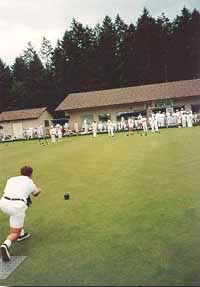
1 year old. Pencross.
Constructed exactly as per book
I was introduced to lawn bowling by my father in 1932 and have been an avid player ever since. We belonged to the Beverly Hills Club for a great many years. We travelled considerably, bowling upon many of the greens of the US and Canada, both east and west.
Until the mid 60's, lawn bowling greens the world over were awful, simply awful. The greenskeepers were almost invariably retired labourers without the slightest idea between the difference of a passable green and a totally neglected one, nor did they care even a little.
The ideal green must be smooth, level (plinth to plinth), have a hard surface (no thatch) with a deep rooted grass (7 to 14 inches).
The key here is a grass which can be cut at 3/16" to 1/4", will stand heavy abuse and recover quickly. Growing grass requires three essentials:
- Oxygen - which is absorbed through the roots, The roots will not penetrate deeper than they can find sufficient oxygen. This is the key.
- Moisture - sufficient, but only as the grass desires. Do not drown your turf.
- Food - inorganic fertilizer, almost always in the form of pellets. Never organic, never.
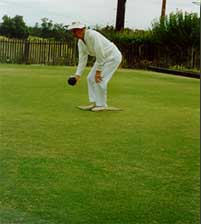
lawnbowling
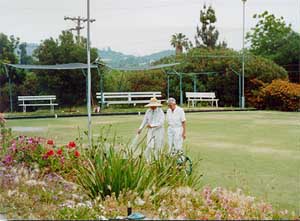
Until the mid 60's, we played lawn bowls on surfaces that were not hard, not level and not smooth. And as I found out as time went on, these miserable surfaces were present in all the greens in the US and Canada and at least much of the rest of the bowling world. They were awful, simply awful. The bowl hopped and bounced half way down from weeds or other irregularities, the draw of the two sides was vastly different.
Nearly always there were large bare areas from compaction. And there was always at least an inch of thatch. The speed was no more than 8 to 9 seconds. Few women could reach a long jack.
Feeling that we could produce a much better surface, we constructed a four rink green on my property in Escondido, CA, filling the area within the plinths with the best quality of soil. We worked long and hard, but after two years our green was much the same as those around us. No greenskeeper seemed to know anything that would help us. It was most discouraging.
One day I came across a short article from the research department of the University of California, extolling the growing of grass in pure washed sand, and having a hard surface. I was excited and immediately spent two weeks at the University learning a huge amount about the growing of grass and especially, growing in pure sand.
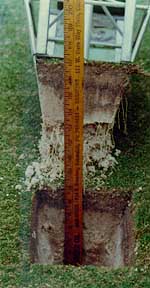
Supporting roots 9" deep.
Frail feeding roots 4" to 5" deeper
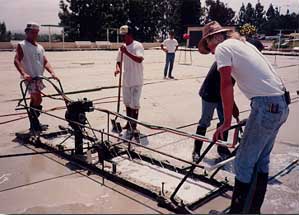
For grass to grow, there must be the exact amount of moisture, nourishment (fertilizer) and above all there must be oxygen at the root level.
Grass takes its oxygen through its roots and the roots will go down only as far as oxygen is available. The growth in sand lies upon two well understood scientific principles. There is no guess work nor theory involved: gravity & surface tension, etc.
Gravity - for our purposes, gravity is the pull to the earth by all substances.
Surface Tension - for our purposes - is the attraction of water to any wettable surface.
Water in a glass always has a curve-up just as the water meets the glass. Or, a small capillary tube will pull up water (surface tension) until the weight of the water (gravity) is equal.
Sand, of course, is composed of tiny stones between which there is a network of holes or tubes; some large, some very small through which water is attracted by surface tension. Gravity empties the larger tubes. The smaller tubes, having a greater ratio of surface per unit of water holds the water against the gravity.
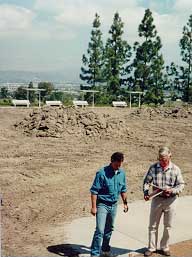
Construction of greens
Leisure World, Ca.
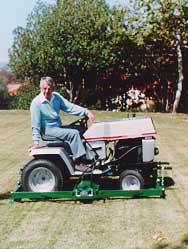
Early model, hydraulic
Suppose we do a little experiment, which is nicely detailed in the yellow book, "The Construction of the Lawn Bowling Green", p.76 - 80, showing that the amount of water held by sand is related to the depth of the sand. As the depth of the sand is increased, the upper levels hold progressively less water and therefore more air than the levels below.
This invariably results in longer and stronger roots. When you obtain a really strong grass you can then do almost anything to it and expect it to come back relatively quickly.
The Escondido green was apparently the first green ever to be intelligently constructed from pure washed sand, at least in the US and Canada (as quoted by the University).
At the beginning, we tried all kinds of ideas and methods, finally coming out with somewhat of a routine. We did all the work except the mowing and top dressing.
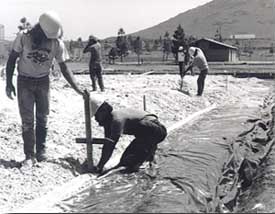
Note wire level with plinth
During the author's active lifetime, the Escondido green:
- was mowed three times a week, overlapping by 50%, making 4 cuts in all except usually for one month (dormancy in winter) at a height of usually 3/16". We bowled regardless.
- except when it was actually raining, we bowled daily.
- we used the greensplaner three times a week during summer. At other times, use was related to thatch development.
- has never been rolled.
- has not been plugged for the past 15 years.
- has not had to be sprayed for fungus.
- has had no weed killer applied except for a recurrent small patch of Poa, for 2 weeks, then not a sprig til the next year.
- has never had a bare area, pure washed sand cannot be compacted. Short mats are always used.
- was surveyed 2 times a year at + or - 1/8" contours on 5' centers. Rarely wass there more than + or - 1/4" out of level, plinth to plinth.
- was perfect: the speed, day in and day out, was 12 1/2 to 13 seconds, able to be brought to 15 seconds when needed.
- the surface of the Escondido green was never too wet to play on, except during the actual raining.
- the green was never watered until at the 2" depth the grass wass so dry that the tensiometer read above 16 or 17 centibars of mercury.
The art of lawn bowling construction suffered a great loss with the death of Edgar R. Haley in October, 1998. His wish was that his knowledge not die with him.
His two manuals, "The Construction of the Lawn Bowling Green" and "The Maintenance of the Lawn Bowling Green" are the considered the "gold standard" for greens.
He also created a TV video "Construction of a Lawn Bowling Green" in 1987 which is often referred to in the yellow (Construction) manual. This video was put together by Woodruff Ogdenand the Haley family is very grateful for his efforts in doing this. We have now made this and the manuals into digital formats and they, along with print manuals are available for purchase HERE.
His world famous method of constructing Lawn Bowling Greens is being continued by Steve Caulkins. Please click here for lawn bowling green construction or consultations.
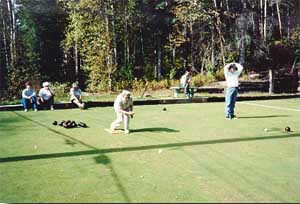
The most northerly green in North America.
Literally cut out of heavy forest.


